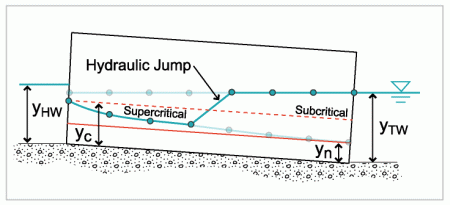Hydraulic Jumps |
Whenever the flow profile changes from supercritical to subcritical, hydraulic jumps will occur. A hydraulic jump represents a significant head loss that manifests in available energy for scour and creation of turbulence. Hydraulic jumps are one of the three occurrences of Rapidly Varied Flow that FishXing approximates. Hydraulic jumps are generally an undesirable condition for fish passage and erosion control.

 Photos
of Hydraulic
Jump,
Hydraulic
Jump
2,
Photos
of Hydraulic
Jump,
Hydraulic
Jump
2,
In FishXing a hydraulic jump can only occur if the following two conditions are satisfied:
1. The culvert has a steep hydraulic slope (yc > yn)
2. The tailwater depth is greater than critical depth (yTW > yc)
If both of these conditions exist FishXing checks for the possibility of a jump occurring within the culvert. FishXing solves the Gradually Varied Flow equations in the downstream direction (frontwater calculations) starting from critical depth at the inlet. This gives a supercritical water surface profile. Next, FishXing performs backwater calculations starting at the outlet with the water depth equal to the tailwater depth. Proceeding upstream, the backwater calculations produces a subcritical water surface profile. At any given point in the culvert there is now both a supercritical and subcritical depth. To determine which depth is correct, at each node (point) the corresponding momentum (or specific force) is calculated for both of the depths. When the upstream momentum and downstream momentum values are equal a jump occurs.
FishXing does not locate the exact location of the jump but determines the up and downstream nodes of the jump and connects sub and supercritical flow between these nodes.
The steps followed to locate the jump are summarized as:
1. Compute the upstream supercritical water surface profile by solving the Gradually Varied Flow equations from the inlet depth equal to critical depth. Calculations proceeding in the downstream direction are called "frontwater calculations".
2. Starting at the downstream boundary condition at the outlet, compute the subcritical water surface profile in the upstream direction. Calculations proceeding in the upstream direction are called "backwater calculations".
3. At each node, compute the momentum (specific force) for associated with the two depths (supercritical and subcritical).

Where:
M = Momentum or specific force
Q = Flow rate
g =Acceleration due to gravity
A = Cross sectional area
zbar = is the distance from the water surface to the centroid of the cross sectional area of flow.
4. Beginning at the outlet and proceeding towards the inlet, compare the momentum associated with the corresponding supercritical and subcritical depths. When the momentum associated with the subcritical profile becomes less than the momentum associated with the supercritical profile, a hydraulic jump is assumed to have occurred between the two nodes.